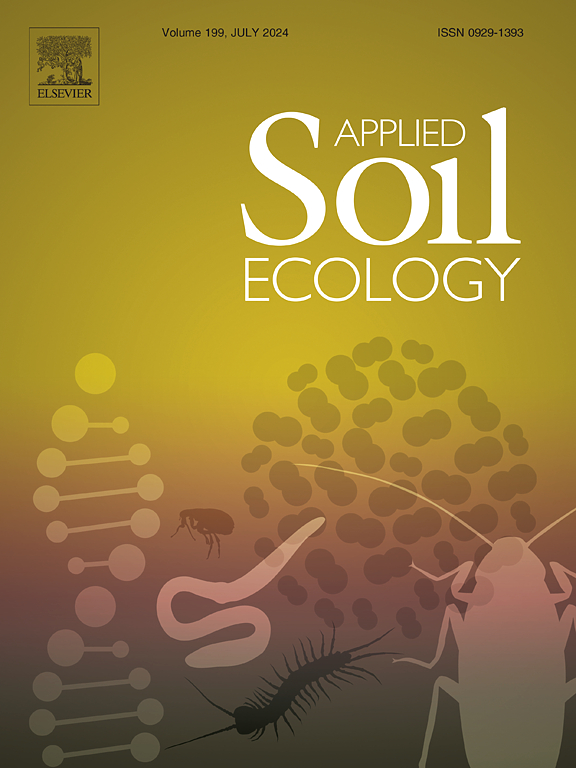Mixing of Pinus massoniana and broadleaved tree species alters stoichiometric imbalances between plants and soil microbes and their resources in subtropical plantations
IF 4.8
2区 农林科学
Q1 SOIL SCIENCE
引用次数: 0
Abstract
Substituting broadleaved trees for some existing coniferous industrial timber trees is an increasingly common cultivation practice to increase productivity, and non-isometric variations in soil carbon (C), nitrogen (N), and phosphorus (P) availability may make it challenging for plants and soil microbes to meet their elemental requirements. However, how plants and soil microbes cope with imbalanced stoichiometry induced by changes in the dominant species to maintain homeostasis remains unclear. We investigated the C:N:P stoichiometry in Pinus massoniana monocultures and in mixed plantations of Pinus massoniana and five individual broadleaved trees (Bretschneidera sinensis, Manglietia conifera, Cercidiphyllum japonicum, Michelia maudiae, and Camellia oleifera). We found that species substitution alleviated soil N-P imbalances for plants; it also alleviated the imbalances in soil accessible resources and litter C:P & N:P for microbes, thus reducing plant and microbial P limitations but aggravated potential microbial C limitations. Lowering the annual N and P uptake ratio and reabsorbing more P relative to N were two important ways that plants decreased the soil N-P imbalance. Increasing microbial biomass, enzymatic activities, and the microbial element utilization ratios C:P and N:P were important mechanisms by which microbes decreased C:P and N:P imbalances with substrates. The synergistic response of plant P uptake vs. microbial P assimilation and plant nutrient resorption efficiency (N:P) vs. microbial element utilization ratio (N:P) implied a mutually reinforcing relationship between plants and microbes in response to stoichiometric imbalances. Overall, these results advance the understanding of the plant- and microbe-driven alleviation of P limitation synergistically in P-scarce fragile ecosystems.

用阔叶树代替一些现有的针叶工业用材树是一种越来越常见的提高生产力的种植方法,而土壤中碳(C)、氮(N)和磷(P)供应量的非等比变化可能会使植物和土壤微生物在满足其元素需求方面面临挑战。然而,植物和土壤微生物如何应对由优势物种变化引起的不平衡的化学计量以维持平衡仍不清楚。我们研究了马尾松单一种植园和马尾松与五种阔叶树(Bretschneidera sinensis、Manglietia conifera、Cercidiphyllum japonicum、Michelia maudiae 和 Camellia oleifera)混合种植园的 C:N:P 化学计量。我们发现,物种替代缓解了植物的土壤氮磷失衡;同时也缓解了土壤可利用资源和废弃物中 C:P & 的失衡;缓解了微生物的氮磷失衡,从而减少了植物和微生物的磷限制,但加剧了微生物潜在的碳限制。降低氮和磷的年吸收比以及相对于氮吸收更多的磷是植物减少土壤氮磷失衡的两个重要途径。增加微生物生物量、酶活性以及微生物元素利用比 C:P 和 N:P,是微生物降低基质 C:P 和 N:P 失衡的重要机制。植物对 P 的吸收与微生物对 P 的同化、植物对养分的吸收效率(N:P)与微生物对养分的利用率(N:P)之间的协同反应,意味着植物和微生物在应对化学计量失衡时存在相互促进的关系。总之,这些结果加深了人们对缺钾脆弱生态系统中植物和微生物协同缓解钾限制的理解。
本文章由计算机程序翻译,如有差异,请以英文原文为准。
求助全文
约1分钟内获得全文
求助全文
来源期刊

Applied Soil Ecology
农林科学-土壤科学
CiteScore
9.70
自引率
4.20%
发文量
363
审稿时长
5.3 months
期刊介绍:
Applied Soil Ecology addresses the role of soil organisms and their interactions in relation to: sustainability and productivity, nutrient cycling and other soil processes, the maintenance of soil functions, the impact of human activities on soil ecosystems and bio(techno)logical control of soil-inhabiting pests, diseases and weeds.
 求助内容:
求助内容: 应助结果提醒方式:
应助结果提醒方式:


